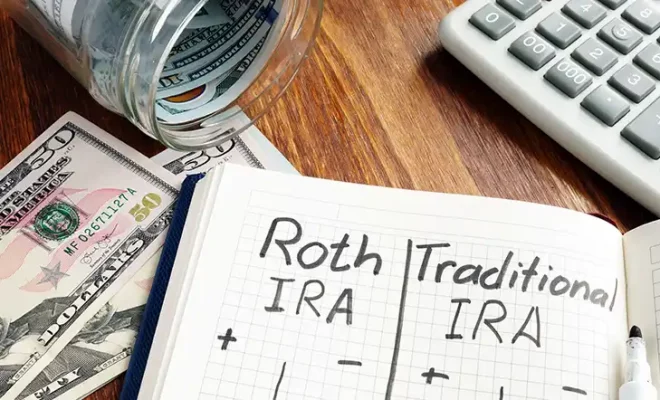4 Types of Retirement Plans To Know
Retirement planning is a critical aspect of financial planning. The earlier you begin, the more likely you are to reap higher rewards. Retirement planning outlines retirement income goals, as well as the actions and decisions necessary to achieve them. It entails identifying sources of income, creating a budget and a savings plan, and managing your assets and risk. In essence, retirement planning is a commitment. Sure, you may begin any moment, but it is better to start sooner rather than at a later stage in life. This will ensure you build a safer and financially secure future. The significance of retirement planning may also vary according to one’s age, risk profile, and other factors. The markets offer a plethora of retirement plans to choose from. If you wish to learn about the pros and cons of different retirement plans, how they are taxed, do they have required minimum distributions (RMDs) or not, and more, do consult with a professional financial advisor who can advise you on the same.
Read further to know more about the various retirement plans available to you to know if they suit your profile:
Table of Contents
How do retirement accounts work?
401(k)s and IRAs are some of the popular retirement accounts that offer investors tax benefits to save for retirement. Traditional 401(k) participants pay taxes on their contributions and returns when they withdraw their funds. However, those who contribute to Roth plans pay taxes on their contributions upfront, allowing them to make tax-free withdrawals in retirement subject to fulfillment of certain conditions. When compared to saving in a “normal” savings account or investing in a brokerage account, retirement plans offer tax advantages. There are other advantages to using a retirement plan, such as an employer match in a 401(k), but the tax advantages are really what set them apart. You may want to assess the retirement plans on the parameters of taxes, plan rules, etc., to find one best suited for you.
Let us read further to know about different kinds of retirement plans in detail:
Types of retirement plans you need to know
One should ideally start planning for retirement as soon as one begins working. Starting a retirement fund early in life will aid in the accumulation of a substantial corpus while compounding works to increase your wealth. Many individuals put off retirement planning because they believe they have a long time before retiring. However, with age, financial responsibilities increase too. When financial obligations are limited, planning for retirement can significantly help alleviate the strain of doing so later.
Hiring a retirement advisor may be in your best interest. The retirement planner may be able to create a comprehensive plan that will allow you to prepare for the contingencies in life while saving up for retirement.
Let us explore some of the most popular retirement plans you may consider for your retirement planning needs:
1. 401(k)
A 401(k) plan is a workplace retirement account that is offered as a benefit to employees. This account allows you to invest a portion of your pre-tax income in tax-advantaged accounts. By investing in a 401(k), you can lower the amount of money you’ll have to pay on taxes that year.
Until you withdraw the money in retirement, investment gains are tax-deferred. However, if you remove funds from the plan before reaching the age of 59 1/2, you may be subject to a 10% penalty as well as federal and state income taxes. You can contribute $20,500 to your 401(k) account in 2022. However, if you are 50 or above, you can make a catch-up contribution of $6,500. If you find yourself in a financial emergency, certain plans allow you to take out 401(k) loans. Some firms match their employees’ 401(k) contributions up to 6% of their salary. However, you wouldn’t be able to take your employer’s contributions with you if you leave the company. With that said, any money you contribute to the plan will always be 100% yours. You could be foregoing a valuable employee benefit if you don’t contribute up to the employer match. Employers who provide these programs are frequently willing to allow you to contribute through automated paycheck deductions, making saving more convenient.
2. IRA
An IRA (Individual retirement account) is a tax-advantaged retirement savings account. After you deposit money into the account, you can use it to invest in stocks, bonds, mutual funds, ETFs, and other assets. You can make the investment decisions yourself unless you wish to hire someone to do it for you. If your workplace doesn’t provide a retirement plan or if you’ve exhausted your 401(k) contributions for the year, you might want to explore investing in a traditional IRA. Many individuals who don’t have a 401(k)retirement account can deduct their IRA contributions on tax returns, lowering their taxable income for the year. There are different types of IRAs, and the taxes on each are handled differently. Read further to know.
-
Traditional IRA
Traditional IRAs offer tax-deferred growth, which means that earnings are not taxed each year as they would be in a regular bank account. Instead, you can reinvest any earnings in the account and benefit from the power of compounding. For 2022, you can make a contribution of $6,000. If you are 50 years of age or above, you can make a catch-up contribution of $1,000, bringing your total to $7,000. You may also be eligible for a tax deduction for contributions to a traditional IRA, allowing you to make ‘pre-tax’ contributions to your account.
-
Roth IRA
If your annual income isn’t too high, a Roth IRA can be one of the best retirement options to invest in. While contributions to a Roth IRA are no longer tax-deductible, withdrawals will be tax-free once you retire. A Roth IRA can also serve as an emergency fund in a pinch because you can withdraw money from it before retirement without paying a penalty. In 2022, you can contribute a maximum of $6,000 each year and an additional $1,000 if you are 50 and above. A Roth IRA offers a wide range of investment possibilities, including mutual funds, equities, bonds, exchange-traded funds (ETFs), certificates of deposit (CDs), money market funds, and more.
-
Spousal IRA
A spousal IRA is a kind of IRA wherein working spouses can contribute on behalf of their non-working spouse. Spousal IRAs are especially designed for married couples. A spousal IRA can be beneficial for married couples who wish to save for retirement even if one spouse is presently not working. The non-working spouse can start a regular IRA or Roth IRA in their own name and contribute according to the family’s income. In most circumstances, you can only contribute the amount that you make each year, not the amount that your family earns. Some married couples can double their IRA retirement savings each year by opening a second IRA and maxing out their contributions.
-
SEP-IRA
A Simplified Employee Pension (SEP) allows employers to contribute to their employees’ retirement plans (SEP-IRA). SEP-IRA retirement plans can be set up and funded by self-employed people as well. SEP-IRAs have various advantages over traditional 401(k) plans, including higher contribution limits and a simpler structure. You can contribute a maximum of $61,000 to a SEP-IRA in 2022. Like ordinary IRAs and Roth IRAs, the money you put into a SEP-IRA can be contributed to after the year to which it applies. The deadline for SEP-IRA contributions may be pushed back to coincide with the filing deadline for a tax return. The deadline for establishing a SEP-IRA is the same as for submitting a tax return, plus any extensions.
-
SIMPLE IRA
SIMPLE IRA stands for Savings Incentive Match Plan for Employees Individual Retirement Account. This type of IRA is available for small businesses having 100 or fewer employees. The SIMPLE IRA can be used as a start-up retirement plan for small enterprises that do not currently offer retirement benefits, such as a 401(k) or 403(b) plan. Employees can contribute a maximum of $14,000 in 2022, however, if you are 50 years of age or above, you can make an additional catch-up contribution of $3,000, bringing your total to $17,000.
-
Roth 401k
A Roth 401(k) is a hybrid of a Roth IRA and a 401(k). Offered by employers, it was first established in 2006. Contributions are made from your after-tax paycheck rather than your pre-tax payment, just like a Roth IRA. If you stay in a Roth for at least five years, your contributions and earnings are never taxed again. Similar to a traditional 401(k), you can contribute $20,500 in 2022 and an additional $6,500 as a catch-up contribution, if you are 50 years of age or above. The best thing about a Roth 401(k) is that, unlike a Roth IRA, there is no income limit. The annual contributions are the same as a typical 401(k), but they are made after-tax. Withdrawals are similar to those of a Roth IRA, but distribution requirements are similar to those of a standard 401(k).
3. Thrift savings plan (TSP)
A thrift savings plan (TSP) is a type of retirement investment program that is only available to federal employees and uniformed military members, including Ready Reserve members. It is a defined-contribution plan that offers many of the same benefits to government employees as private-sector employees. A TSP resembles a 401(k) plan in many ways. For 2022, an employee can contribute $20,500 annually. If they are 50 years of age or above, they can contribute an additional $6,500 for the same. TSP benefits include automatic payroll transfers and agency matching contributions, to name a few. Contributions to a conventional TSP can be made tax-deferred, which means that the money in the account will not be taxed until it is withdrawn. They can also contribute to a Roth TSP. Employees can contribute to their plans after-tax, which means they will not owe any taxes when they withdraw the assets after retirement. Employees who start working for the federal government can move their 401(k) and individual retirement account (IRA) assets to a TSP, and vice versa if they change jobs.
4. Cash-balance pension plans
A defined-benefit pension plan with the option of a lifetime annuity is referred to as a cash balance pension plan. In a cash balance plan, the employer deposits a specified percentage of a participant’s annual compensation into their account, plus interest costs. Restrictions and requirements related to funding along with investment risk are determined by defined-benefit criteria. Changes in the portfolio have no bearing on the participant’s final benefits upon retirement or termination, and the employer owns the portfolio’s profits and losses. For 2022, you can make a contribution of $61,000 and an additional $6,500 catch-up contribution if you are 50 and up.















